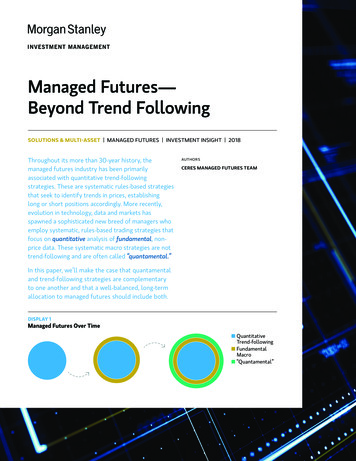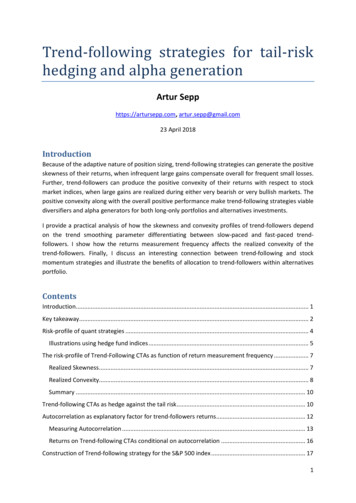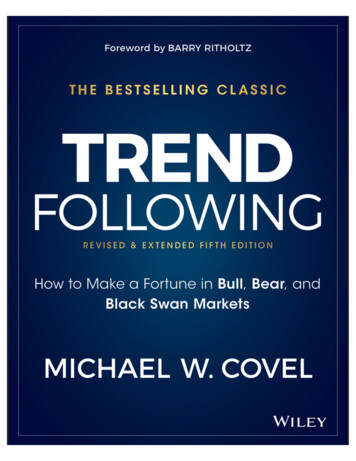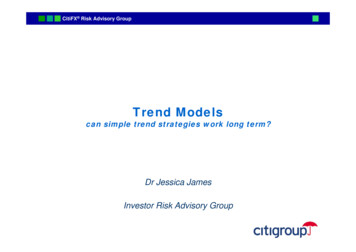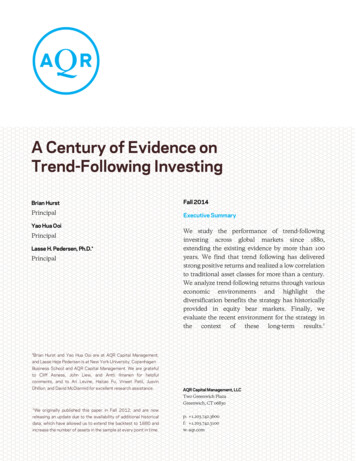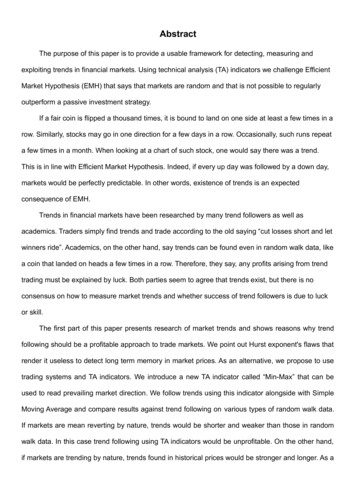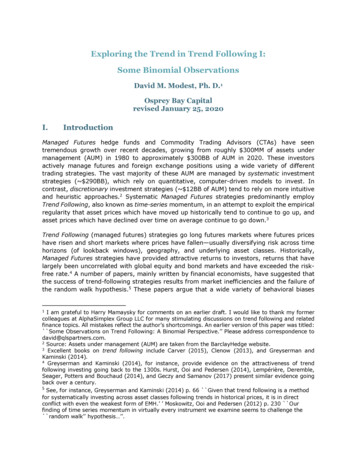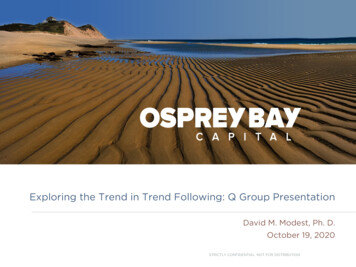
Transcription
THE TRENDFOLLOWING BIBLE
Founded in 1807, John Wiley & Sons is the oldest independent publishing company in the United States. With offices in North America, Europe,Australia, and Asia, Wiley is globally committed to developing and marketingprint and electronic products and services for our customers’ professionaland personal knowledge and understanding.The Wiley Trading series features books by traders who have survived themarket’s ever-changing temperament and have prospered—some by reinventing systems, others by getting back to basics. Whether you are a novicetrader, a professional, or somewhere in between, these books will providethe advice and strategies needed to prosper today and well into the future.For a list of available titles, visit our Web site at www.WileyFinance.com.
THE TRENDFOLLOWINGBIBLEHow Professional Traders CompoundWealth and Manage RiskAndrew AbrahamJohn Wiley & Sons, Inc.
Cover image: Andrew LieferCover design: Danin Tulic/iStockphotoCopyright 2013 by Andrew Abraham, Inc. All rights reserved.Published by John Wiley & Sons, Inc., Hoboken, New Jersey.Published simultaneously in Canada.No part of this publication may be reproduced, stored in a retrieval system, or transmitted in any form orby any means, electronic, mechanical, photocopying, recording, scanning, or otherwise, except as permitted under Section 107 or 108 of the 1976 United States Copyright Act, without either the prior writtenpermission of the Publisher, or authorization through payment of the appropriate per-copy fee to theCopyright Clearance Center, Inc., 222 Rosewood Drive, Danvers, MA 01923, (978) 750-8400, fax (978)646-8600, or on the Web at www.copyright.com. Requests to the Publisher for permission should beaddressed to the Permissions Department, John Wiley & Sons, Inc., 111 River Street, Hoboken, NJ07030, (201) 748-6011, fax (201) 748-6008, or online at http://www.wiley.com/go/permissions.Limit of Liability/Disclaimer of Warranty: While the publisher and author have used their bestefforts in preparing this book, they make no representations or warranties with respect to the accuracyor completeness of the contents of this book and specifically disclaim any implied warranties ofmerchantability or fitness for a particular purpose. No warranty may be created or extended bysales representatives or written sales materials. The advice and strategies contained herein may notbe suitable for your situation. You should consult with a professional where appropriate. Neitherthe publisher nor author shall be liable for any loss of profit or any other commercial damages,including but not limited to special, incidental, consequential, or other damages.For general information on our other products and services or for technical support, please contact ourCustomer Care Department within the United States at (800) 762-2974, outside the United States at(317) 572-3993 or fax (317) 572-4002.Wiley publishes in a variety of print and electronic formats and by print-on-demand. Some materialincluded with standard print versions of this book may not be included in e-books or in print-on-demand. Ifthis book refers to media such as a CD or DVD that is not included in the version you purchased, you maydownload this material at http://booksupport.wiley.com. For more information about Wiley products,visit www.wiley.com.Library of Congress Cataloging-in-Publication DataAbraham, Andrew.The trend following bible : how professional traders compound wealth and manage risk /Andrew Abraham.pages cm. — (Wiley trading series)Includes index.ISBN 978-1-118-40774-5 (cloth); ISBN 978-1-118-42186-4 (ebk),ISBN 978-1-118-43439-0 (ebk), ISBN 978-1-118-41763-8 (ebk)1. Investment analysis. 2. Portfolio management. 3. Investments. 4. Risk management. I. Title.HG4529.A27 2013332.64'5—dc230201204388810 9 8 7 6 5 4 3 2 1
To my Family, Ruthie, Gabrielle,Ariel, Micael, my mother, and allthose who supported me along myjourney of trend following, thankyou.
CONTENTSForewordixPrefaceIntroductionCHAPTER 1xiiiMy Journey as a Trend FollowerGet a Savvy Start19Can You Really Make a Living as aTrend Follower?CHAPTER 2Getting the Most Out of This Method25CHAPTER 3Why Trend Following?35CHAPTER 4How Successful Trend Followers Trade49CHAPTER 5Managing the Risks when Trend Following 81CHAPTER 6Your Complete Robust Trading PlanCHAPTER 7Trend Breakouts107CHAPTER 8Trend Retracements121CHAPTER 9The Trend Follower Mindset137CHAPTER 10My Trading Journal161Conclusion193Disclosure195Index19795vii
FOREWORDI’ve been trading for investors for over 30 years. My first fund, Tactical CommodityFund, started in mid‐1981. Tactical’s current program began in 1993 as an offshootof that first fund but with lower leverage and some evolutionary changes. I’ve learneda lot over the years. I’ve seen a lot of markets, a lot of bull moves, a lot of bear moves.And I can tell you I wish I had read this book 30 years ago. I would have made moremoney, especially near the beginning. Do yourself a favor. Read it. Now.My trading‐for‐investors career began not long after gold peaked around 870 and abit over a year before the S&P bottomed near 100. I subsequently watched gold dropmore than 70 percent over 19 years and then rally over 700 percent in the next 12. Iwatched the stock market rally for over 17 years with just one big, brief pullback alongthe way only to witness two retracements greater than 50 percent in the next 10 years.I’ve seen almost too numerous to remember booms and busts in the commodity,currency, and interest rate markets. I’ve seen things happen that everyone said neverwould and watched as things didn’t happen that everyone said were inevitable. I’vetraded and held positions in these markets nearly every single day since mid‐1981.Tactical was one of the first systematic, computerized fund managers. We startedout on a Radio Shack TRS 80, before the first Apple. Historical data that costs pennies now took months to type in by hand. We ran Fourier transforms and provedthere were in fact no repeatable hidden cycles in the markets while everyone else wasstill talking about them. We tested all the market lore to see what was true and whatwasn’t. We tested the early mechanical systems that were touted and found most ofthem didn’t hold up. Indicators that people still use today we learned years ago don’treally give you a statistical advantage.I wrote my own back‐testing software and tested everything I could think of.Whenpersonal computers advanced we bought the latest. For a number of years we had twoSun workstations running 24/7 doing systems testing when those were state of theart. Of course, now you can do the same things much faster on a laptop. But that wasthen and this is now. We kept testing. We kept learning.ix
THE TREND FOLLOWING BIBLExI read every book I could get my hands on about trading. I listened to the oldtraders. When I worked during summer breaks in college at a brokerage firm at theChicago Board of Trade I kept my ears open as the old‐timers related their adventures,their successes, their failures. I tried to understand the psychology of the winners andhow it differed from that of the losers. I got the idea that the psychology of the traderwas as important if not more important than anything in success or failure.I spent a lot of time learning things the hard way, a lot of trial and error, a lot ofhard knocks. Trading is still a lot of hard knocks. Drawdowns can go on seeminglyforever. You can have days, weeks, even months on end without much in the way ofprofits. It can feel as if you are a punching bag or a movie double who takes all the hits.But that’s the nature of the game, of the business.Even after you’ve learned how to do it, you still take your hits. To succeed, you justneed to stand up every time you get knocked down. You need to have the confidencethat standing up is the right thing to do.You need to know when to stand back up andhow. And just by standing up again and again and staying standing as long as you canbefore you get hit again, well, you can actually make more money than you lose overthe long run in trend trading. It’s quite an amazing process.Very few people succeed in this process. The learning curve is too steep and thecorrect psychology is too hard to implement. If you have any attachment to makingmoney, and who doesn’t, it is very tough to trade correctly.This brings me to the book you hold in your hands. To reiterate: I surely wish I hadhad it 30 years ago. It would have saved me a lot of work. And I would have made moremoney, especially in the early years. More specifically, I would have lost less moneyand that would have put me farther ahead today. Andy Abraham has written a gem. Hiswriting style is enjoyable, clear and entertaining. He covers all the main ingredientsneeded for successful trend trading. He tells the truth.What impresses me most about Andy’s writing is his honesty. He doesn’t sugarcoatthings. He doesn’t tell you it’s easy to make money. He tells you that you need patienceand discipline. (By the way, “Patience and Discipline” has been Tactical’s slogan since itsinception.) Andy tells you drawdowns and losses are part of the business. He presentsa track record of one of his own programs that he started just a few years ago that hasnot made new highs in 17 months. That’s exactly how it works sometimes. What is sorefreshing is Andy’s honesty about it. The man has integrity.A characteristic of those traders who have been successful over many years is honesty with respect to their trading.You need to understand your own psychology, whereyou are mentally strong and weak, how you deal with baser emotions, particularlyfear and greed. If you lack honesty with yourself, you will almost certainly fail. Andy’shonesty, more than anything, tells me he understands trading psychology and givesme confidence he is qualified to teach others what he knows. I have yet to run across atrading book that emphasizes the psychological aspect of trading better than this one.This book is not a cookbook. It does not outline a mechanical system. It explainsthe psychology needed to succeed in trend trading, gives some examples of traders
xiFOREWORDwho have applied it, and sets out the underlying principles that should be followed forsuccess—trade the best markets, trade with the trend, bet small, use stop‐losses, cutlosses, ride winners, don’t overtrade, be patient, be disciplined.As a bonus, Andy gives you the scaffolding for a particular methodology that works forhim as an example of everything he sets out in the basic rules. Just as you would never thinkof moving into a new house that has been framed but before the roof, walls, and interiorare finished, you cannot and should not attempt to trade Andy’s “system” without doingall the finishing carpentry.You need to do your own back‐testing—doable these days withoff‐the‐shelf software he describes—to fill in the parameter values and to learn how histrade‐the‐best market portfolio ranker shuffles which market signals you take. For thosewho don’t have a clue where to begin, Andy gives you his exact pattern to follow.Your ownback‐testing fills in the parameter blanks.Andy advises everyone that they must trade a style that fits their personality. I believe very strongly that he is absolutely correct.You will not follow a system that doesnot suit you. In his wisdom Andy thus does not give you all the parameter values forthe formulas in his personal trading scaffold. He wants you to do your own back‐testing, to find a methodology that you are comfortable with yourself and have confidencein. When all is said and done, your approach may be identical to his with your ownparameter values. It may be significantly different. Regardless, you cannot develop theconfidence to pull the trigger after multiple losses in a row without having done thework yourself. Guaranteed.It’s a fair bet to say that any trend following methodology likely to succeed overtime will employ the general psychological and fundamental trading rules Andy outlines. The specifics of everyone’s approach will vary, but the broad principles outlinedhere will be present in one form or another in virtually all robustly successful trendfollowing approaches. People say that markets have changed and new rules are neededfor the new game. I’ve heard that for over 30 years. The markets do change but theunderlying fundamental rules for success don’t seem to. They are all outlined here.How great.You are lucky to have picked up this book. If you are a seasoned trader, reviewingthe basic elements of winning psychology makes this book worth perusing cover tocover. We can all use reminders, yours truly always. If you are new to trading, thisbook can save you years of trial and error and monetary losses. This book is now onmy short list of recommended reading material for traders. I sincerely thank Andy forhaving written it. Have fun reading it. I wish you all the best in your trading.Dave DruzTactical Investment ManagementCTA / CPO since 1981Haleiwa, HawaiiNovember 2012
P R E FA C EIwanted to write a book that I wished I could have read when I first began to trade.This book is unique and I hope it will give you all the tools needed to help youbecome a successful trader over time. I have had help along the way of my journey oftrend following. Writing a book that encompasses all aspects of trading is my way ofgiving back and helping new and aspiring traders. By teaching and enlightening othersI know I will make a difference in many aspiring traders.Hopefully you will learn from my mistakes and avoid the 18‐year learning curve Ihave been on so far. The lessons I have presented in this book will help you achieve thegoals that you are seeking.I wanted to share my insight—from the perspective of a professional who tradesfor a living—what one goes through on a daily basis and what a trader needs to knowand internalize to become a consistent and successful trader over time. The majorityof books I have read over the years seemed to try to boost my confidence by demonstrating how easy trading success can be. Trading for a living is not easy by a long shot.My goal is to illustrate the major issues and challenges that traders face. I wouldassume there are those readers who would prefer to seek the “easy.” It really does notexist! My purpose and goal was to dispute all the snake oil, hope, hype, unrealistic getrich quick falsehoods. There is no easy money in the markets. You will have to workhard to achieve success.You will make plenty of mistakes; however, look out the frontwindow and learn from your mistakes.I would assume that many of you have picked up this book because you are hopingto improve your trading. My goal is to give specific methods instead of vague generalities that can be used in your everyday trading and improve it. My goal is that youinstill in yourself that ultimately you are the only one responsible for your success orfailure. It is never the market, never the broker, or me, with my advice. I want you torealize that the markets can be cooperative at times and giving, as well as also ruthless and unforgiving. No matter what stage of trading you go through, there will betimes of severe aggravation (if you let it). How you react to the realities of trading willxiii
THE TREND FOLLOWING BIBLExivdetermine if you will be part of the 90 percent who lose money or the small groupof 10 percent who are consistent winning traders over time. My goal is to have yoube part of the 10 percent club of winners; however, it is up to you to truly internalizewhat I am trying to instill in you.Introspectively there were other reasons why I wrote this book. Writing abouttrading actually helps me overcome the inherent difficulties of trading. No one isimmune to the difficulties of trading. Even money managers who have assets inthe hundreds of millions of dollars must face the mental challenges. I have had ablog, TrendFollowingmentor.com, in which I speak and try to educate about trading.Nothing is sugarcoated. I have been told by many colleagues that I focus almost toomuch on telling readers how trading is difficult. The reality is that trading is hard. Ilearned this fact the hard way. This is probably the complete opposite of what youwould have thought when you purchased this book.You probably thought you couldbuy this book and be immediately on your way to making money. Trend following,however, is like a marathon, and I hope it becomes a lifetime strategy for you.On October 31, 2011, MF Global went bankrupt and shocked the futures markets.It is not just the fact that MF Global went bankrupt but that over 1.6 bbillion of clientsegregated funds supposedly “vaporized.” I was a client of MF Global and their predecessor EDF Mann since 1994. Along with many others, I was in shock about whatwas allowed to transpire. This had never happened in the futures markets. Anotherfirm, Refco, blew up due to fraud and the next day clients were made 100 percentwhole. Not so in the case of MF Global. What helps me overcome this frustration wasto write. Over the Christmas holidays in 2011 I decided to write a book on trend following and trading for a living that would be different from all of the existing bookson the market.It was partly due to a catharsis and in conjunction with the request by my oldestdaughter who has been trading with me since she was 13. She had asked me to teachsome of her friends how to trade. I had time on my hands and started to write.My bookshelves are full of trading books. I have read books regarding Warren Buffett, Value Investing, and all the books you can ever imagine on technical trading, butnone of them got me to the point that 18 years of struggle did. I thought the morebooks, the more successful my trading would be. This is why I really believe my bookwill stand out among the many other trading books. I continued on this holy grailsearch with trading systems and formulas. I was so overwhelmed with courses andgurus. I could not figure out why everyone wasn’t rich. I could not understand whymore than 90 percent of traders fail. Many of these 90 percenters are engineers, pilots, and successful people in all types of fields. I read the various success stories oftraders in Market Wizards by Jack Schwager whom I called the 10 percenters and wasencouraged. There are other great books in recent years that focus on successful traders such as Michael Covel’s books Trend Commandments: Trading for Exceptional Returns,Trend Following: How Great Traders Make Millions in Up or Down Markets, and The Little Book
1. Robust trading plan applicable to all time frames and markets.2. Complete risk and money management.xvPREFACEof Trading. There is a great deal of fantastic information to be gleaned from these booksand I strongly recommend them.A driving force for me was to succeed in trading. I did not assume the lure of so‐called“easy money’’; I did not assume it would be easy. I read about Larry Williams who in atrading contest took 10,000 to approximately 1 million.I read in MarketWizards aboutMichael Marcus who started with 30,000 and took that sum to 80 million. RichardDennis was also featured; he started with 400 and ran it up to over 200 million.Thesenumbers were amazing but also dangerous to novice traders like myself at the time. Everyone who trades wants to achieve these results. Just because someone else succeeded,this might really help you.You do not hear of all those who failed and how long it tookthe ones to survive to become successful.Most traders have no concept of what is needed in order to achieve these loftygoals. I assume that all too many traders think this is easy and instead of focusing onwhat needs to be learned, they focus their time and energy on all the ways they couldspend their new‐found riches. Then there are those who invest all their time in searchof holy grail indicators and systems that aren’t.In every business venture before one starts the norm is to make a business plan. Tothe contrary, too many new traders are more focused and anxious to get rich ratherthan to make a business plan. They think they do not have time for the plan. The lureof easy money is a Pandora’s box of problems. The dangers of unrealistic expectationsare more than prevalent. Instead of focusing on all the dangers of trading, too manyare focusing optimistically on their new‐found easy wealth. I can humbly say I madecountless mistakes and I paid for these mistakes, but introspectively I was of the campseeking holy grail systems and indicators, which was a waste of time. These mistakeswere required learning lessons for me in order to become a consistent trader eventhough I had people trying to help me. It is not just me. Behind all the glory of the Market Wizards was the reality. Richard Dennis, the teacher of the Turtles, lost 50 percentof his and his investors’ accounts and has stopped trading. Michael Marcus borrowedmoney from his mother and lost it before he internalized his mistakes! Larry Williams,whose claim to fame was in a trading contest and book, How I Made One Million DollarsLastYear Trading Commodities, lost a million dollars the following year.There are countless stories of unknown traders who have blown up. They focusedtoo much attention on the easy profits they thought they would make. They had noconcept of risk management. They had no concept of hard work. Too many believedthey could buy a trading system or trading robot and find their proverbial retirementin a box.The reality of successful trading comes down to several basic tenets and the realization that you have to work hard:
3. The patience and discipline to follow the trading plan and follow the riskand money management guidelines.On my business card I have written on the back the tenets of successful trend following:1. Trade with the trend.2. Cut your losses.3. Let your profits run.4. Don’t let the big profits get away.THE TREND FOLLOWING BIBLExviOne who follows these simple rules is light years ahead of so many traders. Thesefour rules are similar to the Ten Commandments. If one follows them, one will be“blessed” over time with the trading results. When combining these tenants one putsone’s self in the position to potentially create extreme wealth.A vast majority of traders spend all of their time and energy trying to predictor guess what will occur in the markets. The right activity for traders is look atwhat is happening right now. Be in the moment and just follow the plan (hopefully they have a plan). The question needs to be asked, has the market taken outthe X period high? Has the market retraced and is offering me a low‐risk retracement trade? Bloomberg and CNBC are based on predictions. Everyone wants to besmart and show they know the future. Successful trend followers have internalizedthat it is nothing about being right or predicting. The point that these successfultrend followers have internalized is to identify where they are located currently inrelation to the trend and just take the trade if they have one.As I believe any trade is 50/50, you never know which trade will work. Too manytraders are looking for certainty. Certainty does not exist in the markets. Traders wantto know when trends start and stop. The reality is you never know. The flipside of the50/50 is that you do not know how bad a trade can go against you. The concept ofcutting losses is a paramount issue if one wants to stay in this business. If losses get outof control, one can easily be overwhelmed financially and emotionally.Letting profits run is very hard for some traders. They have that urge to ring thecash register. They do this primarily out of fear. In trend following one needs theserare big winners to offset all of the inherent small losses. Your trading plan must havethe contingent for following trades that are working. This is the key to making moneyin the long run and building your positively sloping equity curve. With a trading planthere is no “Should I”, “Could I”, “Would I”, “Shoot, why didn’t I take that trade,” orworse, “Why did I let this happen to me?” When we trade, we should trade for theprimary reason to make money and build a positive equity curve. This primary reasonis so powerful we are all trying (should be) to better our trading. This is why we tryto perfect our trading. This leads us at times to second guess ourselves. We second
xviiPREFACEguess because we don’t have a plan and do not have discipline. If you are in this stateI believe my book will truly help you develop “the plan” based on risk management,a robust trading methodology, and the proper mindset in which you do not secondguess yourself.One must plan in trading. The extent of planning determines success or failure intrading. The more developed and stringent a trading plan with all potential outcomespreplanned, the greater the potential for success over time. There will be times youwill think to violate your trading plan.You know that you should not; however, rationalization is a powerful tonic.You try to justify your decision to violate your plan. Noone is standing over you and asking you why are you breaking your own rules? Youjust do it, wrongly though. Ironically, Mr. Market might even reward you for breakingyour own rules. This is even worse for your psyche! Breaking your own rules becomesa slippery slope. It becomes easier and easier, and by the way you made some moneylast time.The big issue is you just bought yourself a one‐way ticket to the 90 percent club offailed traders who lose money. The only way you can even hope to join the 10 percentclub of consistently successful traders over time is being consistent in your tradingplan. Consistent means seeing the same type of trade, recognizing it, and taking action. This is repetitive in nature. Actually I was recently told that this was boring. Myanswer was, I am not trading for excitement. I like boring.Without a trading plan how would you know where you are going?Clearly you would not!Even with your trading plan there will always be problems and surprises. Thousands of traders were caught in the MF Global debacle. A situation in which client segregated accounts were violated was an industry first. On Halloween 2011 MF Globalwent bankrupt. Client accounts were frozen. Not just cash was frozen; positions couldnot be offset for days. Frantic traders were calling 24 hours for days trying to exit theirpositions. I know traders that flew to Chicago to try to exit their positions. Anothercolleague of mine had three people on speed dialer trying to get through to the tradedesk, to no avail. This was a nightmare for traders as well as the futures industry. Thefortunate traders who had multiple accounts were able to offset their positions. Othertraders who fortunately had the majority of their funds at Treasury Direct (the U.S.Federal Reserve bank) or at a cash management firm such as Horizon survived. Planning saved traders.Those that did not plan are not in business.Thank God I planned forthe unthinkable and had a vast percentage of assets at Treasury Direct (the U.S. Fed).Luckily due to my paranoia and the advice of a colleague I transferred out some fundsfrom MF Global before they collapsed. I still got burned, however, but not destroyed.The MF Global issue was extreme; anything can and anything will happen in trading.The only certainty is uncertainty. Who would have thought the Nasdaq would still bedown 10 years from the highs? Who would have really believed the Japanese stockmarket would be down from 39,000 to approximately 9,000? What is shocking is that
for 22 years Japan has been in a bear market. If someone told you this could happen inthe U.S. stock markets you would think they were crazy.Who would have ever thoughtgold could go from a couple hundred dollars to almost 2,000 over approximately 10years? Once you truly internalize that anything can happen, you realize the absoluteneed for a complete plan. The markets will always throw you a curveball. Investingyour time and energy in your trading plan will reward you more than the futile searchfor predictions, indicators, and mechanical systems. In my book I am giving you mytrading plan. What a great bargain.A solid trading plan is the holy grail if there really is one!Andrew AbrahamTHE TREND FOLLOWING BIBLExviii
The Trend Following Bible: How Professional Traders Compound Wealth and Manage Riskby Andrew AbrahamCopyright 2013 by Andrew Abraham, Inc.INTRODUCTIONMy Journey as aTrend FollowerThings that happen many times are not a coincidence. Probably today and evenmore so in 1994 very few people had ever heard of the phrases “trend follower”or “trend following.” I stumbled on the phrase “trend following” by sheer luck. I sold abusiness that I started in college in 1994. I had saved the majority of the money overthe years and even acquired more money upon the sale of the business. I had no ideahow to invest it. I was not comfortable with the stock market after witnessing the1987 stock market crash as well as the stock volatility in the early 1990s. As I havealways done, I tried to surround myself with the smartest people I could. I asked myaccountant what he suggested. He told me that he had a client who owned a commodity brokerage firm who was very successful and suggested I meet him. My accountantwas in his mid‐60s with a rather large practice, therefore he had seen a very large poolof clients, and I trusted his unbiased opinion.I wanted to learn how my money could work for me and compound over time. Iwas overwhelmed with all the books and courses that offered so‐called magical successand millionaire traders who really weren’t.I started my journey of learning. Market Wizards by Jack Schwager mesmerized meand has encouraged me. My journey of trend following began. This journey was morelike a marathon and still is.I probably made every mistake possible. Working past mistakes and a bad memo
CONTENTS vii Foreword ix Preface xiii Introduction My Journey as a Trend Follower 1 CHAPTER 1 Get a Savvy Start 9 Can You Really Make a Living as a Trend Follower? CHAPTER 2 Getting the Most Out of This Method 25 CHAPTER 3 Why Trend Following? 35 CHAPTER 4 How Successful Trend Followers Trade 49 CHAPTER 5 Managing the Risks when Trend Following
